Global Nanorobots In Healthcare Market, By Type, By Application, By End User, By Region & Segmental Insights Trends and Forecast, 2024 – 2034
- Industry: Healthcare
- Report ID: TNR-110-1320
- Number of Pages: 420
- Table/Charts : Yes
- September, 2024
- Base Year : 2024
- No. of Companies : 10+
- No. of Countries : 29
- Views : 10054
- Covid Impact Covered: Yes
- War Impact Covered: Yes
- Formats : PDF, Excel, PPT
Nanorobots in healthcare are microscopic machines designed to perform precise medical tasks at the cellular or molecular level. These robots are used in various applications, such as targeted drug delivery, cancer detection, and surgery. For instance, in 2023, researchers developed nanorobots capable of delivering chemotherapy directly to cancer cells, reducing side effects. In diagnostics, nanorobots help identify diseases at early stages by navigating through the bloodstream and detecting abnormal cells.
Nanorobots are also used in minimally invasive surgeries, enhancing precision and recovery times. Adoption is rapidly increasing due to advancements in nanotechnology and rising healthcare demands. In 2024, it was reported that nanorobots played a key role in wound healing by speeding up tissue repair. Their ability to work at a molecular level makes them crucial in modern medical treatment and everyday healthcare solutions.
“In Terms of Revenue, the Global Nanorobots In Healthcare Market was Worth US$ 6.6 Bn in 2023 and is Anticipated to Witness a CAGR of 7.3% During 2024 – 2034.”
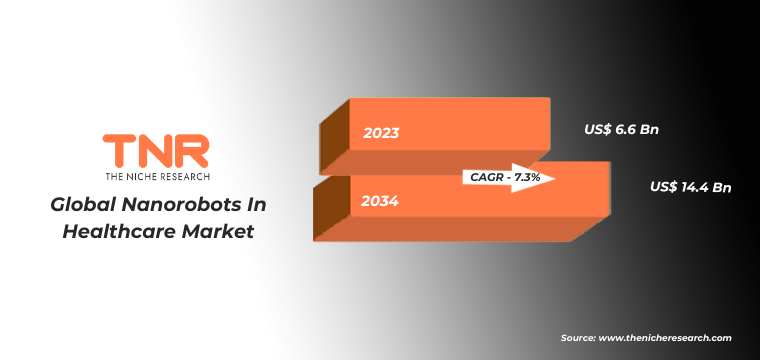
Nanorobots In Healthcare Market Dynamic
Growth Driver-
Rising Prevalence of Chronic Diseases, Particularly Cancer
Nanorobots offer precision in targeting cancer cells, reducing damage to healthy tissue. For example, in 2023, researchers successfully used nanorobots to deliver chemotherapy drugs directly to cancerous cells, minimizing side effects. This technology is also being explored for its potential in treating neurodegenerative diseases, such as Parkinson’s and Alzheimer’s. In 2024, nanorobots were used in a pilot study to target plaque in arteries, opening new doors for cardiovascular treatments. The demand for minimally invasive treatments, coupled with the growing need for advanced medical technologies, continues to drive the adoption of nanorobots in healthcare.
Trends-
Increasing Integration of Artificial Intelligence (AI) & Machine Learning (ML) Technologies
AI enables nanorobots to operate with higher precision, enhancing their ability to diagnose diseases, deliver drugs, and perform surgeries. For instance, in 2023, AI-powered nanorobots were used in clinical trials to navigate complex biological environments and detect cancer cells with improved accuracy. Another example is the use of ML algorithms to optimize nanorobots for personalized treatments, particularly in gene therapy and regenerative medicine. In 2024, AI-driven nanorobots were tested to enhance wound healing processes, marking a shift towards more intelligent and autonomous healthcare solutions. This trend is reshaping how nanorobots interact with human biology.
Challenge-
High Cost of Development and Deployment
Creating nanorobots requires advanced materials and sophisticated manufacturing processes, which significantly increases production costs. For example, in 2023, a study highlighted that developing nanorobots for cancer treatment involved expensive materials like graphene and gold, driving up the cost of research and development. Additionally, the regulatory approval process is lengthy and complicated due to safety concerns, as nanorobots interact at the cellular level. In 2024, regulatory bodies hesitated to approve certain nanorobot applications due to potential risks of toxicity and long-term effects, further delaying their market entry. These financial and regulatory hurdles hinder wider adoption and accessibility.
Diverse Applications of Nanorobots Across Various Healthcare Sectors:
| Healthcare Sector | Application | Description | Example |
| Oncology | Targeted Drug Delivery | Nanorobots deliver chemotherapy directly to tumor cells, reducing side effects and enhancing efficacy. | In 2023, a study demonstrated nanorobots successfully targeting breast cancer cells, minimizing collateral damage. |
| Diagnostics | Disease Detection | Nanorobots can navigate the bloodstream to identify and report abnormalities at the cellular level. | A 2024 research project showcased nanorobots detecting early-stage cardiovascular diseases by identifying plaque. |
| Surgery | Minimally Invasive Procedures | Nanorobots assist in precision surgeries, allowing for less invasive techniques and faster recovery times. | In 2023, nanorobots were used in a minimally invasive procedure to remove kidney stones without traditional surgery. |
| Gene Therapy | Gene Editing | Nanorobots can be programmed to modify genes, offering potential cures for genetic disorders. | A 2024 breakthrough involved using nanorobots to deliver CRISPR components for gene editing in muscular dystrophy. |
| Regenerative Medicine | Tissue Repair | Nanorobots promote cell regeneration and tissue repair in injured areas, enhancing healing processes. | In 2023, studies revealed nanorobots improving wound healing by delivering growth factors directly to damaged tissues. |
| Neurology | Brain Treatments | Nanorobots can cross the blood-brain barrier to deliver medications for neurological diseases. | In 2024, a pilot study showed nanorobots effectively delivering Alzheimer’s drugs directly to targeted brain regions. |
| Diabetes Management | Insulin Delivery | Nanorobots provide precise insulin delivery, maintaining optimal blood sugar levels in diabetic patients. | In 2023, research indicated that nanorobots could autonomously monitor glucose levels and release insulin as needed. |
| Infectious Diseases | Targeting Pathogens | Nanorobots can identify and neutralize pathogens, such as bacteria and viruses, in the bloodstream. | A 2024 study demonstrated nanorobots successfully targeting and eradicating drug-resistant bacteria in vitro. |
Nanorobots In Healthcare Market Segmentation:
By Type
Nanomanipulators segment by type is poised to dominate the nanorobots in healthcare market, accounting for a significant 45.7% revenue share during the forecast period. Nanomanipulators are used for precision manipulation of biological components at the molecular level, enhancing applications in surgery, drug delivery, and diagnostics. In 2023, researchers used nanomanipulators to perform minimally invasive surgeries, improving patient outcomes and reducing recovery times. Additionally, nanomanipulators are being employed in gene therapy, allowing for the precise alteration of DNA sequences. In 2024, advancements in nanomanipulators enabled highly accurate manipulation of proteins for targeted cancer therapies, making this segment crucial for expanding the role of nanotechnology in modern healthcare solutions.
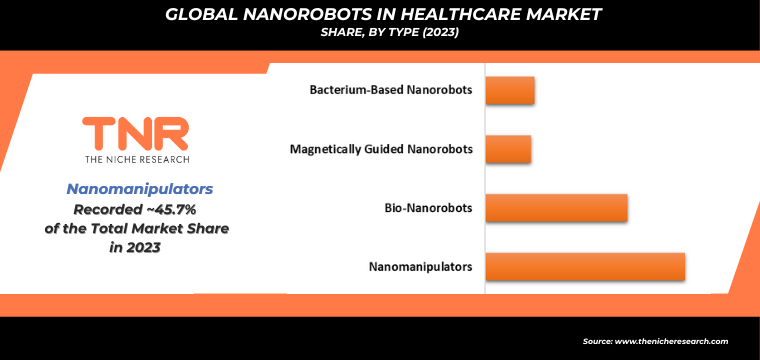
By Application
Drug delivery segment has taken the lead in the nanorobots in healthcare market and is expected to be the fastest-growing application, securing a substantial revenue share of 21.4% over the forecast period. This dominance is due to nanorobots’ ability to deliver medications directly to targeted cells or tissues, enhancing treatment effectiveness and minimizing side effects. For instance, in 2023, researchers utilized nanorobots to transport chemotherapy drugs specifically to cancer cells, significantly reducing harm to healthy cells. Additionally, nanorobots have been explored for precise insulin delivery in diabetic patients, improving glucose regulation. In 2022, a breakthrough study demonstrated nanorobots crossing the blood-brain barrier to treat neurological conditions like Alzheimer’s disease. These examples highlight how nanorobots are revolutionizing drug delivery by making treatments more targeted and efficient.
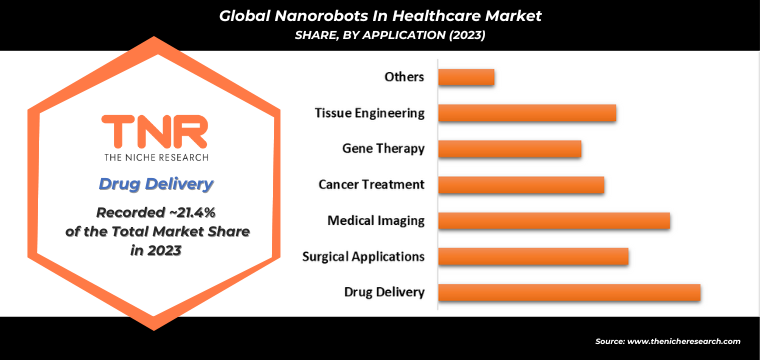
By End User
Hospitals and clinics segment has emerged as the dominant player in the nanorobots in healthcare market, capturing a notable 39.5% revenue share. This growth is driven by the widespread adoption of nanorobots for various medical procedures, including minimally invasive surgeries and diagnostics. In 2023, hospitals began utilizing nanorobots to improve precision in cancer treatments and surgical interventions, resulting in better patient outcomes. Clinics have also started using nanorobots for early disease detection, such as identifying cardiovascular conditions at an early stage. As healthcare providers increasingly rely on advanced technologies, the demand for nanorobots in clinical settings continues to rise, ensuring enhanced efficiency and accuracy.
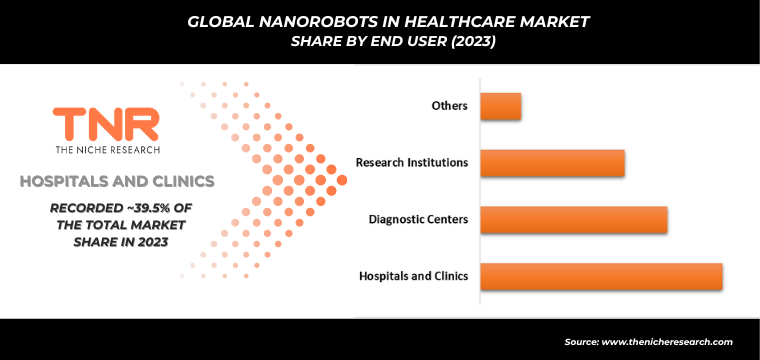
By Region
In 2023, Latin America is expected to play a key role in driving the growth of the nanorobots in healthcare market, contributing around 11.4% to its overall expansion. The region’s increasing investment in healthcare infrastructure and the adoption of advanced medical technologies are boosting this growth. For example, Brazil has been at the forefront of implementing nanorobotics in cancer treatment, aiming to improve patient outcomes. In Mexico, nanorobots have been tested for early disease detection, enhancing diagnostic accuracy. Additionally, government initiatives promoting research and innovation in nanotechnology are further accelerating market growth in Latin America, making it a crucial region for the future of nanorobotics in healthcare.
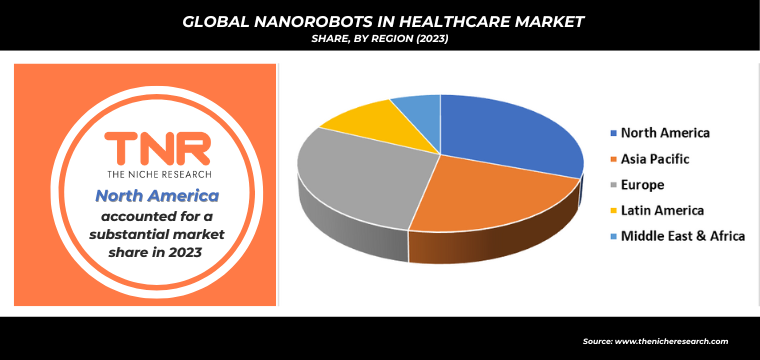
Major Players in Nanorobots In Healthcare Market
- Bruker
- Creative Biolabs
- DNA Nanobots, LLC
- Ginkgo Bioworks
- Hummingbird Scientific
- JEOL Ltd.
- Kleindiek Nanotechnik GmbH
- Klocke Nanotechnik GmbH
- Nanonics Imaging Ltd.
- SmarAct GmbH
- Theranautilus
- Other Industry Participants
Global Nanorobots In Healthcare Market Scope:
| Report Specifications | Details |
| Market Revenue in 2023 | US$ 6.6 Bn |
| Market Size Forecast by 2034 | US$ 14.4 Bn |
| Growth Rate (CAGR) | 7.3% |
| Historic Data | 2016 – 2022 |
| Base Year for Estimation | 2023 |
| Forecast Period | 2024 – 2034 |
| Report Inclusions | Market Size & Estimates, Market Dynamics, Competitive Scenario, Trends, Growth Factors, Market Determinants, Key Investment Segmentation, Product/Service/Solutions Benchmarking |
| Segments Covered | By Type, By Application, By End User, By Region |
| Regions Covered | North America, Europe, Asia Pacific, Middle East & Africa, Latin America |
| Countries Covered | U.S., Canada, Mexico, Rest of North America, France, The UK, Spain, Germany, Italy, Nordic Countries (Denmark, Finland, Iceland, Sweden, Norway), Benelux Union (Belgium, The Netherlands, Luxembourg), Rest of Europe, China, Japan, India, New Zealand, Australia, South Korea, Southeast Asia (Indonesia, Thailand, Malaysia, Singapore, Rest of Southeast Asia), Rest of Asia Pacific, Saudi Arabia, UAE, Egypt, Kuwait, South Africa, Rest of Middle East & Africa, Brazil, Argentina, Rest of Latin America |
| Key Players | Bruker, Creative Biolabs, DNA Nanobots, LLC, Ginkgo Bioworks, Hummingbird Scientific, JEOL Ltd., Kleindiek Nanotechnik GmbH, Klocke Nanotechnik GmbH, Nanonics Imaging Ltd., SmarAct GmbH, Theranautilus |
| Customization Scope | Customization allows for the inclusion/modification of content pertaining to geographical regions, countries, and specific market segments. |
| Pricing & Procurement Options | Explore purchase options tailored to your specific research requirements |
| Contact Details | Consult With Our Expert
Japan (Toll-Free): +81 663-386-8111 South Korea (Toll-Free): +82-808- 703-126 Saudi Arabia (Toll-Free): +966 800-850-1643 United Kingdom: +44 753-710-5080 United States: +1 302-232-5106 E-mail: askanexpert@thenicheresearch.com
|
Key Developments:
- In January 2024, DNA Nanobots, a prominent company specializing in the design and delivery of DNA nanoparticles for targeted therapies, announced the successful completion of its pre-seed funding round. This funding will allow the company to introduce its BioPharma Partner Program, designed to streamline the creation of custom biopharma solutions, from concept to development, for preclinical and animal studies. This initiative aims to improve therapeutic delivery.
- In February 2023, Nanobots Therapeutics, a spin-off from IBEC and ICREA, began developing nanorobots with superior tumor penetration abilities.
- In June 2018, Bruker acquired JPK Instruments AG, enhancing its life science microscopy portfolio and adding mechanobiology measurement capabilities.
Global Nanorobots In Healthcare Market
By Type
- Nanomanipulators
- Bio-Nanorobots
- Magnetically Guided Nanorobots
- Bacterium-Based Nanorobots
By Application
- Drug Delivery
- Surgical Applications
- Medical Imaging
- Cancer Treatment
- Gene Therapy
- Tissue Engineering
- Others
By End User
- Hospitals and Clinics
- Diagnostic Centers
- Research Institutions
- Others
By Region
- North America (U.S., Canada, Mexico, Rest of North America)
- Europe (France, The UK, Spain, Germany, Italy, Nordic Countries (Denmark, Finland, Iceland, Sweden, Norway), Benelux Union (Belgium, The Netherlands, Luxembourg), Rest of Europe)
- Asia Pacific (China, Japan, India, New Zealand, Australia, South Korea, Southeast Asia (Indonesia, Thailand, Malaysia, Singapore, Rest of Southeast Asia), Rest of Asia Pacific)
- Middle East & Africa (Saudi Arabia, UAE, Egypt, Kuwait, South Africa, Rest of Middle East & Africa)
- Latin America (Brazil, Argentina, Rest of Latin America)
Report Layout:
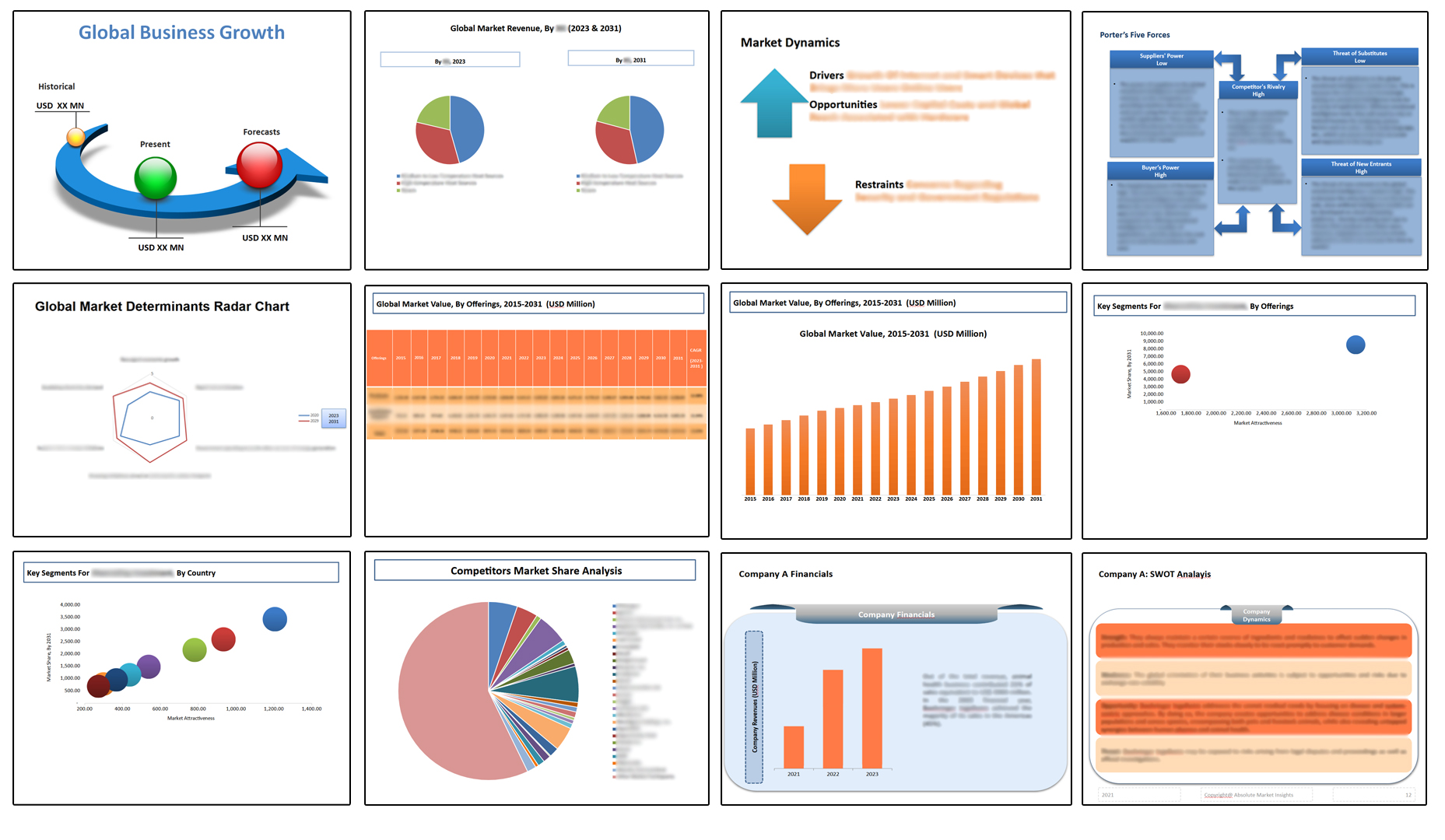
Table of Contents
Note: This ToC is tentative and can be changed according to the research study conducted during the course of report completion.
**Exclusive for Multi-User and Enterprise User.
Global Nanorobots In Healthcare Market
By Type
- Nanomanipulators
- Bio-Nanorobots
- Magnetically Guided Nanorobots
- Bacterium-Based Nanorobots
By Application
- Drug Delivery
- Surgical Applications
- Medical Imaging
- Cancer Treatment
- Gene Therapy
- Tissue Engineering
- Others
By End User
- Hospitals and Clinics
- Diagnostic Centers
- Research Institutions
- Others
By Region
- North America (U.S., Canada, Mexico, Rest of North America)
- Europe (France, The UK, Spain, Germany, Italy, Nordic Countries (Denmark, Finland, Iceland, Sweden, Norway), Benelux Union (Belgium, The Netherlands, Luxembourg), Rest of Europe)
- Asia Pacific (China, Japan, India, New Zealand, Australia, South Korea, Southeast Asia (Indonesia, Thailand, Malaysia, Singapore, Rest of Southeast Asia), Rest of Asia Pacific)
- Middle East & Africa (Saudi Arabia, UAE, Egypt, Kuwait, South Africa, Rest of Middle East & Africa)
- Latin America (Brazil, Argentina, Rest of Latin America)
The Niche Research approach encompasses both primary and secondary research methods to provide comprehensive insights. While primary research is the cornerstone of our studies, we also incorporate secondary research sources such as company annual reports, premium industry databases, press releases, industry journals, and white papers.
Within our primary research, we actively engage with various industry stakeholders, conducting paid interviews and surveys. Our meticulous analysis extends to every market participant in major countries, allowing us to thoroughly examine their portfolios, calculate market shares, and segment revenues.
Our data collection primarily focuses on individual countries within our research scope, enabling us to estimate regional market sizes. Typically, we employ a bottom-up approach, meticulously tracking trends in different countries. We analyze growth drivers, constraints, technological innovations, and opportunities for each country, ultimately arriving at regional figures.Our process begins by examining the growth prospects of each country. Building upon these insights, we project growth and trends for the entire region. Finally, we utilize our proprietary model to refine estimations and forecasts.
Our data validation standards are integral to ensuring the reliability and accuracy of our research findings. Here’s a breakdown of our data validation processes and the stakeholders we engage with during our primary research:
- Supply Side Analysis: We initiate a supply side analysis by directly contacting market participants, through telephonic interviews and questionnaires containing both open-ended and close-ended questions. We gather information on their portfolios, segment revenues, developments, and growth strategies.
- Demand Side Analysis: To gain insights into adoption trends and consumer preferences, we reach out to target customers and users (non-vendors). This information forms a vital part of the qualitative analysis section of our reports, covering market dynamics, adoption trends, consumer behavior, spending patterns, and other related aspects.
- Consultant Insights: We tap into the expertise of our partner consultants from around the world to obtain their unique viewpoints and perspectives. Their insights contribute to a well-rounded understanding of the markets under investigation.
- In-House Validation: To ensure data accuracy and reliability, we conduct cross-validation of data points and information through our in-house team of consultants and utilize advanced data modeling tools for thorough verification.
The forecasts we provide are based on a comprehensive assessment of various factors, including:
- Market Trends and Past Performance (Last Five Years): We accurately analyze market trends and performance data from preceding five years to identify historical patterns and understand the market’s evolution.
- Historical Performance and Growth of Market Participants: We assess the historical performance and growth trajectories of key market participants. This analysis provides insights into the competitive landscape and individual company strategies.
- Market Determinants Impact Analysis (Next Eight Years): We conduct a rigorous analysis of the factors that are projected to influence the market over the next eight years. This includes assessing both internal and external determinants that can shape market dynamics.
- Drivers and Challenges for the Forecast Period:Identify the factors expected to drive market growth during the forecast period, as well as the challenges that the industry may face. This analysis aids in deriving an accurate growth rate projection.
- New Acquisitions, Collaborations, or Partnerships: We keep a close watch on any new acquisitions, collaborations, or partnerships within the industry. These developments can have a significant impact on market dynamics and competitiveness.
- Macro and Micro Factors Analysis:A thorough examination of both macro-level factors (e.g., economic trends, regulatory changes) and micro-level factors (e.g., technological advancements, consumer preferences) that may influence the market during the forecast period.
- End-User Sentiment Analysis: To understand the market from the end-user perspective, we conduct sentiment analysis. This involves assessing the sentiment, preferences, and feedback of the end-users, which can provide valuable insights into market trends.
- Perspective of Primary Participants: Insights gathered directly from primary research participants play a crucial role in shaping our forecasts. Their perspectives and experiences provide valuable qualitative data.
- Year-on-Year Growth Trend: We utilize a year-on-year growth trend based on historical market growth and expected future trends. This helps in formulating our growth projections, aligning them with the market’s historical performance.
Research process adopted by TNR involves multiple stages, including data collection, validation, quality checks, and presentation. It’s crucial that the data and information we provide add value to your existing market understanding and expertise. We have also established partnerships with business consulting, research, and survey organizations across regions and globally to collaborate on regional analysis and data validation, ensuring the highest level of accuracy and reliability in our reports.









